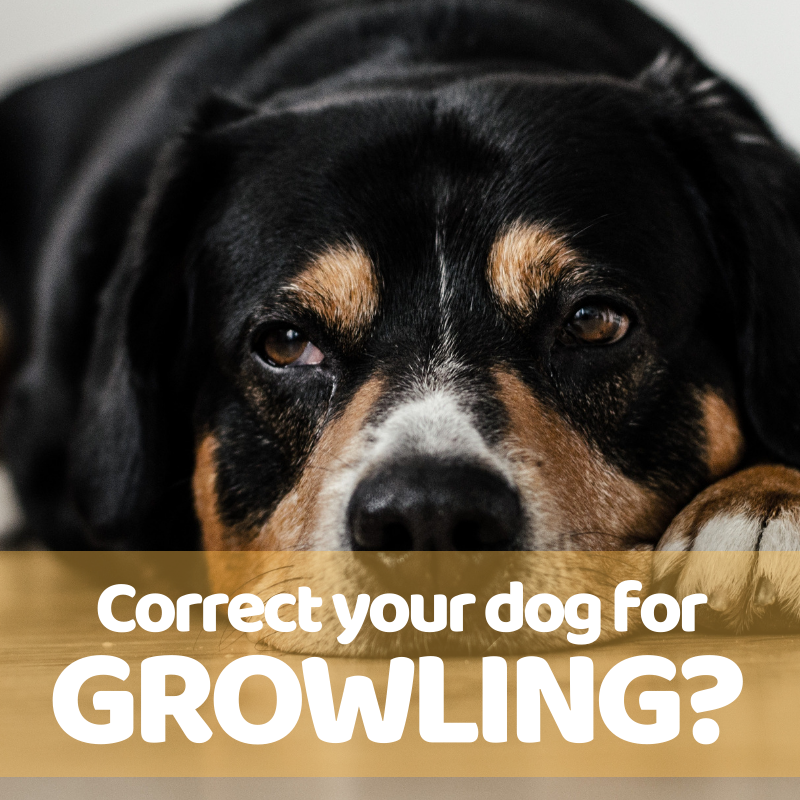Should you correct your dog for growling?
A question I get frequently and one that’s worth investigating. The answer….drum roll, please…. Sometimes yes, sometimes no.
A common sentiment among dog owners, trainers, and most other pet professionals is that you should never correct your dog for growling because if you do, your dog will stop growling and go directly to a bite the next time. While this is true, it’s not the full story.
First of all, we need to define the fact that there are different types of growling.
–Play growling.
Play growling is very common, and not an issue. Some breeds growl a lot when playing, especially when playing a game of tug of war. Should this be corrected? Nah. These dogs are just having fun.
–Fear-based growling.
Many trainers suggest that all growling is fear based, and for that reason, these dogs should not be corrected for growling because it’s valuable communication. Not all dogs growl out of fear, but the majority do. Fear-based growling is heard when a dog is fearful and trying to get space so that they can feel more secure. So correcting them is not the answer, giving them more options is a more fitting alternative. Counter conditioning (yeah, I just went all dog trainer on you) is the process of changing a dog’s emotional response. CC can be very helpful when helping a dog see a fearful situation as fun or confidence producing. Give these dogs options, give them space, and give them tasty treats in the process.
–Manipulation growling.
A less common form of growling, but one that I see weekly as a dog trainer who works almost exclusively with reactive and aggressive dogs. Some dogs learn that growling at people will get people to back away from them. Typically these dogs don’t bite people when given the chance, and none of these dogs growl at other dogs in the same way. Why? because other dogs see what they are doing, and don’t put up with it.
–Intimidation growling.
Some dogs growl as a form of intimidation. They know that growling makes people feel insecure and they growl as a way to make themselves feel better about their lack of confidence. Mostly seen in dog/human situations like the manipulation growling, but this form of growling often leads to biting.
–OCD growling.
Over the years I’ve seen a few dogs who would growl at their owners just to pass the time. Dogs who would get off their bed, walk over to their owners and growl at them while they were being petted. It’s weird, I know. It didn’t seem to be a form of manipulation or intimidation. I’ve only seen this in Goldens and Border Collies to date.
–Predatory growling.
Predatory growling is extremely rare and thank-heavens. It’s heard right before a dog lunges at something it wants to kill. If you hear that growl, it’s probably too late. It’s a very quick, guttural growl. I correct dogs for this type of growling, you better believe it’s butter baby!
So when is it admissible to correct a dog for growling? First, you’ll need to define why your dog is growling. I don’t correct dogs who are growling out of fear, but I do correct dogs for plenty of other types of growling.
Wait a sec, isn’t it true that correcting a dog for growling will make the dog less reliable because they will no longer growl before they bite? Yes and no. When done properly, correction can not only stop the growling, but also the funky state of mind behind the growling. Correcting growling/dirty thoughts is a big component to making dogs safe over the long term. A good trainer can use correction and not only stop the growling but the vibes that lead to the bite too.
I am working with a 100lb+ dog who walks around the living room, pacing, behind a baby gate, growling his face off when the owners eat. He likes bacon, he wants bacon, and he’s a jerk. He’s bitten his owners several times and he’s a serious dog. We are nearing the portion of training where we will start correcting him for this manipulative behavior. He’s a massive manipulator and intimidator who will back things up with a bite. It’s not fear, he’s an ass.
I prefer to correct the act of lunging/snapping first, then correct the dog later (if needed) for dirty thoughts. This can be done with a prong collar, but I prefer to use an ecollar because I can give the correction at a distance.
Hope you learned something, if you did, share the post.
